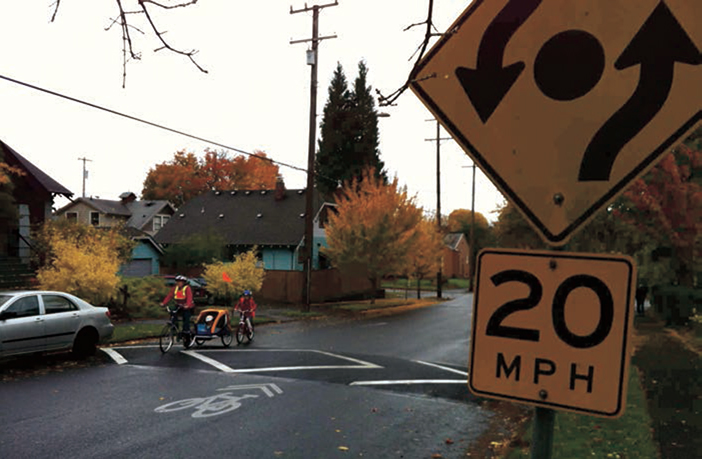
Speed Management

PORTLAND, OR
Speed Management measures for bicycle boulevards bring motor vehicle speeds closer to those of bicyclists. Reducing speeds along the bicycle boulevard improves the bicycling environment by reducing overtaking events, enhancing drivers’ ability to see and react, and diminishing the severity of crashes if they occur. Speed management is critical to creating a comfortable and effective bicycle boulevard.
Streets developed as bicycle boulevards should have 85th percentile speeds at 25 mph or less (20 mph preferred). Speed management (traffic calming) measures can be divided into vertical or horizontal features. These measures can be implemented individually or in combination to increase their efficacy. Common combinations include raised crosswalks with pinchpoints, raised intersections with pinchpoints, and speed humps with center island narrowings, chicanes, or pinchpoints.131
Reduced Speed Limits
Bicycle boulevards should have a maximum posted speed of 25 mph. Some jurisdictions are starting to sign residential speed limits below 25 mph. Simply changing the speed limit is unlikely to reduce speeds; speed management and street design techniques are necessary. Once actual speeds decrease, lower speed limit signs can reinforce the desired speed with regulatory control. Targeted enforcement is also recommended.
Reduced speed limits may require authorizing legislation. The MUTCD designates that speed limits shall be in increments of 5 mph and requires an engineering study to reduce the speed below the statutory speed for the type of roadway. In some jurisdictions, speed limits may be reduced beyond the statutory residential speed limit. State statutory limits might restrict the maximum speed limit that can be established on a particular road.132

ALBUQUERQUE, NM
Vertical Deflection
Vertical speed control measures are composed of wide, slight pavement elevations that self-enforce a slower speed for motorists. Note: the type of narrow, abrupt speed bumps used in private driveways or parking lots are not recommended for public streets and are a hazard to bicyclists.
Some examples of recommended speed management treatments include the following:

Speed humps are 3 to 4 inches high and 12 to 14 feet long, such that speeds are reduced to 15 to 20 mph. They are often referred to as “bumps” on signage and by the general public.133
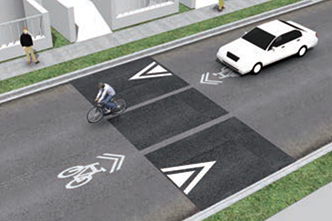
Speed cushions or speed lumps are either speed humps or speed tables that include wheel cutouts to allow large vehicles to pass unaffected, while reducing passenger car speeds. They can be offset to allow unimpeded passage by emergency vehicles and are typically used on key emergency response routes. They should be used with caution, however, as people driving sometimes seek out the space between the lumps, reducing the traffic calming effect and causing unpredictable driving.134
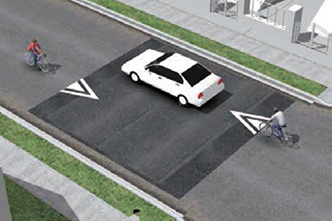
Speed tables are longer than speed humps and flat-topped, with a height of 3 to 3.5 inches and a length of 22 feet. Vehicle operating speeds range from 25 to 35 mph, depending on the spacing, and speed tables may be used on collector streets and/or transit and emergency response routes.
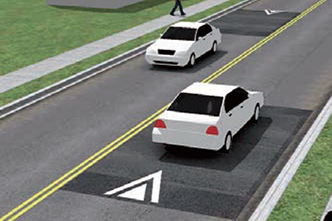
Split speed tables are also 22 feet long and extend across one direction of travel lanes from the centerline. A longitudinal gap is provided to allow emergency vehicles to weave around the treatment. While studies have indicated that this treatment does not reduce speeds below 25 mph, it has been found to deter cut-through traffic, particularly by large trucks.135
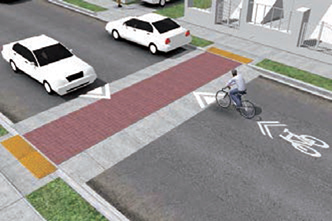
A raised crosswalk is a speed table that is marked and signed for pedestrian crossing. It extends fully across the street, can be longer than a typical speed table, and is typically 3 inches high. An entire minor intersection can be raised to reduce motor vehicle speeds in all directions.136
Horizontal Deflection
Horizontal speed control measures cause motorists to slow down in response to either a visually narrower roadway or a need to navigate a curving travel lane. Where traffic calming features do not extend beyond the parking lane, they visually narrow the road and improve the approaching bicyclists’ view of cross traffic, but do not act as speed management. “When motor vehicle speeds are already below target thresholds, elements can either extend into the travel lane or narrow a bi-directional street to a single lane. Under these conditions bicyclists are comfortable taking the lane and overtaking cars do not encroach on bicyclists’ space. Where possible, provide sufficient space for bicyclists to pass around the outside of the elements.
Examples of horizontal deflection include the following:
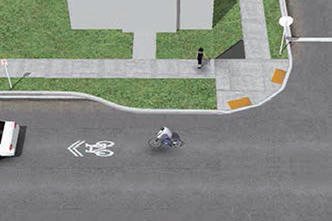
Curb extensions or bulb-outs extend the sidewalk or curb face into the parking lane at an intersection. When placed on the bicycle boulevard, they visually narrow the roadway. Curb extensions on the cross street act as a minor street crossing. All curb extensions reduce the crossing distance for pedestrians, can increase the amount of space available for street furniture and trees, and can act as stormwater management features.
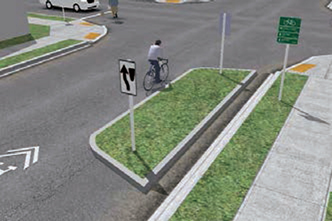
Edge islands are curb extensions that leave a 1- to 2-foot gap by the curb to improve drainage.
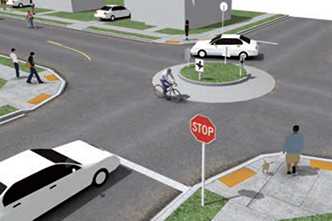
Neighborhood traffic circles are minor street crossing treatments that also provide speed management. They are raised or delineated islands placed at intersections that reduce vehicle speeds by narrowing turning radii, narrowing the travel lane, and, if planted, obscure the visual corridor along the roadway. It should be noted that the City of Portland has found such circles to be less effective than frequently spaced speed humps, and many people on bicycles complain that motorists overtake them when approaching the circles, creating a hazardous condition.137
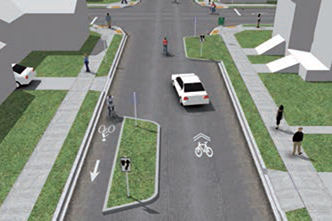
Chicanes are a series of raised or delineated curb extensions, edge islands, or parking bays on alternating sides of a street forming an S-shaped travel way. This reduces vehicle speeds by requiring drivers to shift laterally through narrowed travel lanes.138
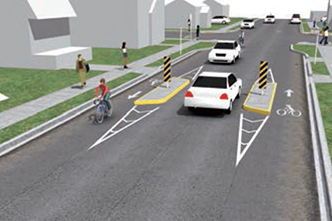
A pinchpoint or choker narrowing includes curb extensions or edge islands placed on either side of the street to narrow the center of the lane such that two drivers have difficulty passing through simultaneously. Pinchpoints should only be used where traffic speeds are already low. Cut-through passageways should be provided to the outside of the pinchpoint to accommodate bicyclists.139

Neckdowns are pinchpoints at intersections; they are minor street crossing treatments that narrow at least one side of an intersection using curb extensions or edge islands on both sides of the street. They are often combined with parking bays on side streets off of commercial main streets.140
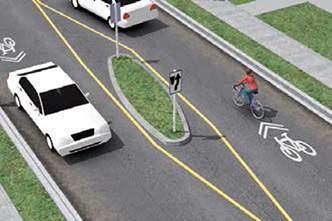
A short center island narrowing is a median parallel to the bicycle boulevard that causes a small amount of deflection without blocking driveway access (such treatments can also act as median refuge islands for pedestrians crossing the bicycle boulevard, but in this configuration it is not a crossing treatment for the bicycle boulevard). Medians can be used for volume management and to assist in bicycle turns at offset intersections.141
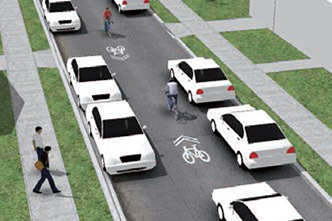
Skinny streets or queuing streets are narrow residential streets that require low motor vehicle speeds and accommodate travel in a bi-directional lane. These types of streets act as traffic calming as drivers must yield to each other to allow one direction of travel at a time to pass.142

BERKELEY, CA
Benefits
Decreases motor vehicle speeds.143
Decreases the likelihood that crashes will occur, by increasing drivers’ response time and minimizing motor vehicles overtaking movements.
Decreases the likelihood of an injury resulting from a crash.144
Improves bicyclist comfort and benefits pedestrians and residents by reducing traffic speeds along the corridor.
Establishes and reinforces bicycle priority on bicycle boulevards by discouraging through vehicle travel.
Provides opportunities for landscaping and other community features such as benches, message boards, and colored pavement in the intersection, benefiting all roadway users and residents.
Typical Applications
Bicycle boulevards where motor vehicle speeds are at or above posted speed or established target speed.145
Streets where the neighborhood feels traffic speeds are too high and are supportive of speed management treatments.
Streets where minor street crossing improvements to reduce bicycle delay (e.g., flipping stop signs to favor the bicycle boulevard) may otherwise encourage higher motor vehicle volumes and/or speeds.
At high-use pedestrian crossings of a bicycle boulevard (raised crosswalk or intersection).
Anywhere green infrastructure or sewer improvements are desired; bioswales can be integrated into the design of curb extensions, chicanes, pinchpoints, and narrowings.
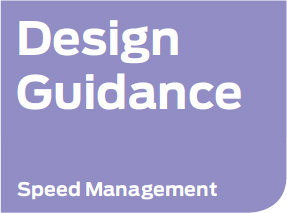

Required Features
 When using horizontal speed management treatments, a minimum clear width of 12 feet for travel shall be maintained.
When using horizontal speed management treatments, a minimum clear width of 12 feet for travel shall be maintained.
 Speed limits shall comply with local restrictions.
Speed limits shall comply with local restrictions.
 Speed zones (other than statutory speed limits) shall only be established on the basis of an engineering study that has been performed in accordance with traffic engineering practices (MUTCD 2B.13).
Speed zones (other than statutory speed limits) shall only be established on the basis of an engineering study that has been performed in accordance with traffic engineering practices (MUTCD 2B.13).
 Speed limits shall be in multiples of 5 mph and signs shall be located at the points of change from one speed limit to another (MUTCD 2B.13).Recommended Features
Speed limits shall be in multiples of 5 mph and signs shall be located at the points of change from one speed limit to another (MUTCD 2B.13).Recommended Features
Recommended Features
 Emergency services should be in sync with transportation departments in recognizing that reducing speed and volume on local roadways, in addition to getting more people on foot and bike and out of cars, benefits their overall safety goals by reducing crash frequency and severity. The primary way of doing this is to develop an emergency response route classification map at the onset of the planning process, as discussed in route planning. Emergency vehicle response times should be considered where vertical deflection is used. Because emergency vehicles have a wider wheel base than passenger cars, speed lumps/cushions allow them to pass unimpeded while slowing most traffic.
Emergency services should be in sync with transportation departments in recognizing that reducing speed and volume on local roadways, in addition to getting more people on foot and bike and out of cars, benefits their overall safety goals by reducing crash frequency and severity. The primary way of doing this is to develop an emergency response route classification map at the onset of the planning process, as discussed in route planning. Emergency vehicle response times should be considered where vertical deflection is used. Because emergency vehicles have a wider wheel base than passenger cars, speed lumps/cushions allow them to pass unimpeded while slowing most traffic.
Strategies include the following:
• S eek approval by emergency response officials for treatments on emergency response routes.
• Allow a limited set of emergency-vehicle-friendly traffic calming techniques on emergency response routes.146
• Estimate travel time impacts on emergency vehicle response time, and define goals to evaluate during a trial.147
• I mplement speed management treatments on a trial basis, and work with emergency response officials to determine whether permanent features are appropriate.
 Speed management treatments should be used to reduce the street’s target speed to 20 mph.
Speed management treatments should be used to reduce the street’s target speed to 20 mph.
 After speed management measures are implemented, posted speed limits should be reduced to match 85th percentile speed (5 mph speed increments are recommended).
After speed management measures are implemented, posted speed limits should be reduced to match 85th percentile speed (5 mph speed increments are recommended).
 The impacts to traffic on adjacent streets should be monitored; while speed management treatments primarily affect motor vehicle speeds, they also reduce volumes, as drivers tend to avoid slower streets.148
The impacts to traffic on adjacent streets should be monitored; while speed management treatments primarily affect motor vehicle speeds, they also reduce volumes, as drivers tend to avoid slower streets.148
 Vertical deflection features should be placed regularly along a corridor to reduce speeds.149
Vertical deflection features should be placed regularly along a corridor to reduce speeds.149
 Guidance for vertical traffic calming features:
Guidance for vertical traffic calming features:
• S lopes should not exceed 1:10 or be less steep than 1:25.
• S ide slopes on tapers should be no greater than 1:6 to reduce the risk of bicyclists losing their balance.
• T he vertical lip should be no more than a quarter-inch high (Ewing, 2009).
 Horizontal speed control measures should not infringe on bicycle space. Where possible, provide a bicycle route outside of the element to avoid bicyclists having to merge into traffic at a narrow pinchpoint. This technique can also improve drainage flow and reduce construction and maintenance costs.
Horizontal speed control measures should not infringe on bicycle space. Where possible, provide a bicycle route outside of the element to avoid bicyclists having to merge into traffic at a narrow pinchpoint. This technique can also improve drainage flow and reduce construction and maintenance costs.
Optional Features
 Speed management may be implemented on a trial basis to gauge residents’ support prior to finalizing the design. Temporary speed humps, tables, and lumps are available. Temporary traffic calming should be used with caution as they can diminish residents’ opinions due to unappealing design and reduced functionality.
Speed management may be implemented on a trial basis to gauge residents’ support prior to finalizing the design. Temporary speed humps, tables, and lumps are available. Temporary traffic calming should be used with caution as they can diminish residents’ opinions due to unappealing design and reduced functionality.
Depending on motor vehicle speeds, a bicyclist will be passed by a car going the same direction this many times during a 10 minute trip: 20 MPH 30% increase 25 MPH in passing over 20 MPH 50% increase 30 MPH in passing over 20 mph PASSING EVENTS: 0 5 10 15 20 25 30 35

Values shown assume 3,000 VPD. Local street peak hour is 15 percent of ADT. 70 percent of peak hour traffic is in the peak direction. Cars are evenly spaced along the street: no platooning. Ten minute trip calculated during peak hour. Cars are travelling the posted speed limit (speed management techniques may be necessary). Note: Cars may pass bicyclists more or less frequently depending on how well these assumptions reflect reality.

BALTIMORE, MD
Maintenance
In cities with snowy winters, traffic calming should be designed to minimize impacts to snow removal operations through the use of reflective delineators on horizontal treatments and sinusoidal transitions to vertical treatments that allow plow blades to track over the change in elevation. Temporary traffic control devices can be used and may be removed in the winter, when speeds are generally slower.150
Vegetation should be regularly trimmed to maintain visibility and attractiveness.
Treatment Adoption and Professional Consensus
Many cities in the U.S. have neighborhood traffic calming programs or public works departments that have installed speed humps or traffic circles. Cities that have designated bicycle boulevards have implemented a variety of speed management treatments. Just greater than half of the jurisdictions with traffic calming programs surveyed for the U.S. Traffic Calming Manual (Ewing, 2009) use trial installations to test speed and volume management techniques. Treatment Adoption and Professional Consensus